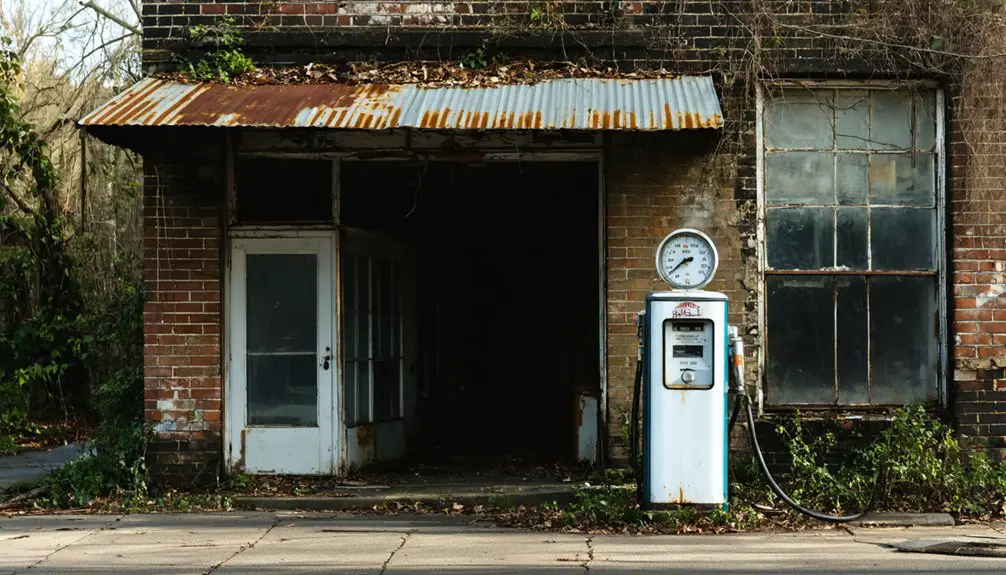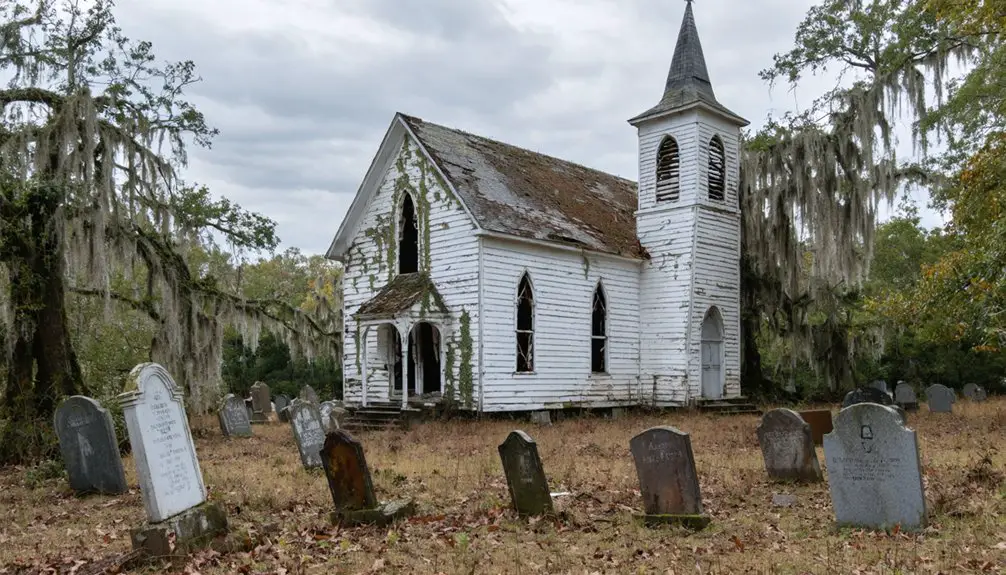You’ll find Leigh’s ghost town remnants in Aiken County, South Carolina, where it once thrived as a textile and farming community. The town’s decline began when major railroads bypassed it, and economic pressures mounted during the Great Depression. B.F. Davis’s store and the Leigh Banana Case Company (1905-1952) marked its industrial peak before federal land acquisition in 1950 forced residents to relocate. Today, abandoned structures and weathered gravestones tell a compelling story of rural American transformation.
Key Takeaways
- Leigh became a ghost town after federal land acquisition in 1950 forced residents to relocate and dismantled the local economic framework.
- The town’s decline accelerated when major railroad companies bypassed it, isolating the community from vital commerce routes.
- Main Street now stands abandoned with deteriorating structures, boarded windows, and collapsed roofs as evidence of its ghost town status.
- Agriculture and textile industries collapsed due to falling commodity prices, poor soil conditions, and inability to adapt to market changes.
- Historical remnants include abandoned rail beds, concrete chutes from coal operations, and weathered gravestones in old cemeteries.
The Rise and Fall of a Rural Community
While Leigh, South Carolina once exemplified the importance of rural communities in the American South, its story ultimately chronicles the challenges faced by small agricultural towns.
You’ll find that Leigh’s community resilience centered on its textile mills and farming operations, which sustained the town’s modest but self-sufficient economy. Similar to Andersonville’s fate, the town suffered from severe flooding that damaged vital infrastructure.
Despite the town’s determination, its isolation from major transportation routes severely limited its growth potential. As younger residents sought opportunities elsewhere, the cultural memory of this once-vibrant community began to fade.
External pressures, including flooding, poor soil conditions, and regional competition, gradually eroded Leigh’s economic foundation. Like many other paper towns of the era, Leigh existed primarily in planning documents but never fully developed into the thriving settlement its founders envisioned.
The town’s decline reflects a broader pattern seen throughout rural South Carolina, where shifting economic landscapes transformed thriving communities into ghost towns.
Historical Roots and Early Settlement
The story of Leigh’s decline begins with its modest origins in Aiken County, where early settlers established a rural community alongside neighboring towns like Ellenton, Dunbarton, and Meyers Mills.
You’ll find that settlement patterns reflected typical post-Civil War development, with scattered family farms dotting the landscape rather than concentrated urban clusters.
These pioneering residents built their lives around agricultural practices suited to South Carolina’s piedmont region, supported by small-scale trading and essential services.
The Stagecoach Inn, built in 1745, served as a vital stopover point for travelers in the region until its relocation and eventual destruction by fire.
While nearby railroad connections influenced the area’s viability, Leigh remained primarily dependent on farming and local commerce. Like many other near-ghost towns in South Carolina, the central business district gradually emptied as transportation routes changed.
The town’s social fabric was woven through church gatherings and community events, with most inhabitants being native-born South Carolinians who relied on dirt roads and basic infrastructure to sustain their rural way of life.
Economic Forces Behind Abandonment
Leigh’s decline began when shifting railroad routes bypassed the town, cutting off essential transportation links that had supported local trade and commerce.
You’ll find that this isolation coincided with the collapse of the area’s primary industries, which likely included resource extraction or agricultural processing operations that couldn’t sustain profitability without reliable rail access.
The town’s fate mirrored that of Ellenton, where federal land acquisition forced thousands to relocate, though Leigh’s abandonment stemmed from economic rather than government causes.
The town’s fate was further sealed by broader agricultural market shifts that plagued many South Carolina communities, as falling commodity prices and changing production patterns left local farmers unable to maintain economic stability. The lack of access to banking services in the region’s interior made it especially difficult for local businesses to secure the capital needed for adaptation and survival.
Railroad Bypass Impact
Driven by mounting debts from ambitious rail expansions, major railroad companies made strategic decisions to bypass smaller towns like Leigh in favor of more profitable routes.
The railroad’s heavy debt load from its failed Cincinnati extension attempt foreshadowed similar financial pressures that would lead companies to abandon smaller routes.
Early attempts to build this critical route cost over one million dollars by 1859 before the South Carolina legislature refused additional funding.
This railroad expansion reshaped transportation corridors, leading to traffic diversion that isolated Leigh from essential commerce and trade networks.
You’ll see how the bypass devastated Leigh’s economy in three key ways:
- Local businesses dependent on rail traffic, including supply stores and hotels, faced closures.
- Industrial and agricultural producers lost competitive advantage without direct rail access.
- Population declined as residents moved to towns with better rail connectivity.
The impact proved irreversible, as subsequent railroad consolidations and abandonments further diminished Leigh’s transportation relevance, ultimately contributing to its ghost town status.
Local Industry Collapse
While railroad diversion dealt a significant blow to Leigh’s connectivity, federal land acquisition in 1950 delivered the final devastating punch to the town’s economic viability.
The government’s seizure of land for the Savannah River Plant forced about 6,000 residents to relocate, dismantling the local economic framework.
You’ll find that this industry decline hit particularly hard as farms shut down, small manufacturers closed, and African-American sharecroppers lost their livelihoods.
The economic migration that followed proved irreversible – younger residents rarely returned, and the remaining elderly population struggled to survive.
Without any replacement industries or recovery plans, Leigh’s economy crumbled, much like towns that lost their poultry processing workers to deportations.
The town’s small-scale manufacturing and agricultural base vanished, leaving behind an economic vacuum that accelerated its abandonment.
Agricultural Market Shifts
Agricultural transformation in post-Civil War South Carolina struck at the heart of Leigh’s economic foundation, as the abolition of slavery dismantled traditional plantation systems and forced a shift to tenant farming and sharecropping.
The town’s farmers faced dramatic market pressures that reshaped local agriculture. Former tenant farmers like Charles Garrett and Ellen Murray gained legal ownership of small parcels along local roads, marking a significant shift in land distribution.
You’ll recognize three major shifts that spelled trouble for Leigh’s agricultural economy:
- Former plantation owners abandoned labor-intensive rice cultivation for diverse crops like corn, potatoes, and vegetables.
- The 1920s brought devastating price collapses and overproduction cycles that bankrupted many local farms.
- The Great Depression delivered the final blow, forcing widespread foreclosures despite New Deal attempts to stabilize prices.
Leigh’s inability to adapt to crop diversification and new tenant farming systems ultimately contributed to its abandonment, as agricultural commerce shifted to larger market centers.
Daily Life in Old Leigh

In old Leigh, you’d find residents gathering frequently at mill-sponsored events, church socials, and school functions that formed the backbone of community life.
Local commerce centered around the company store and small markets, where families could purchase goods with mill-issued scrip or engage in bartering with neighboring farms.
While most families maintained small vegetable gardens and some livestock to supplement their mill wages, these agricultural traditions gradually diminished as the textile industry’s demands on workers’ time increased.
Social Gatherings and Events
Life in old Leigh revolved around vibrant social gatherings that strengthened community bonding through shared experiences and traditions.
You’d find neighbors congregating on porches, town squares, and church grounds, where seasonal traditions like harvest celebrations and Sunday picnics brought everyone together. Churches served as the heart of social life, hosting weddings, potlucks, and holiday festivities.
Key aspects of Leigh’s social fabric included:
- Evening entertainment featuring folk music sessions, storytelling, and ghost tales
- Communal support networks that formed during seasonal labor, crop harvests, and times of hardship
- Educational gatherings at schoolhouses where elders passed down local knowledge and skills
The train depot and general store functioned as informal meeting spots where you’d exchange news and plan upcoming social activities.
Commerce and Local Markets
Commerce in old Leigh centered around a network of family-owned general stores and railway-connected markets that shaped daily economic life.
You’d find bustling local trade at establishments like B.F. Davis’s store near Little Pee Dee River, which started as a river-dependent supply point in 1867 before evolving with improved transportation routes. The arrival of railroads transformed market dynamics, connecting rural communities to broader commercial opportunities and establishing new supply chains for manufactured goods.
The Leigh Banana Case Company exemplified the area’s industrial growth, producing innovative packaging for agricultural products from 1905 until 1952.
Country stores adapted to changing times, offering credit through store ledgers and eventually adding modern conveniences like gas pumps, though many ultimately succumbed to shifting economic conditions.
Family Farm Traditions
While local merchants supplied Leigh’s families with manufactured goods, the heart of daily sustenance came from their own farmsteads. The family farm relied on clear labor roles, with men handling heavy fieldwork while women managed food preservation, gardening, and textile production.
Children contributed by tending animals and gathering resources. These seasonal rhythms guided daily life, where your success depended on:
- Rising with the sun to maximize daylight hours for planting, tending, and harvesting
- Preserving food through smoking, salting, and pickling to sustain through winter months
- Maintaining a network of extended family to share labor during intense periods
Your farmstead’s self-sufficiency centered on practical knowledge passed through generations, from crop rotation techniques to weather-responsive planning, all supported by simple but functional homes and outbuildings.
Remnants and Physical Evidence Today

Today, the abandoned Main Street of Leigh, South Carolina stands as a monument to its ghost town status, with multiple deteriorating structures that once formed the town’s commercial heart.
You’ll find boarded windows, collapsed roofs, and weathered wooden frames throughout the site, while aggressive vegetation steadily reclaims the town’s remains.
Old rail beds and concrete chutes from former coal operations persist, though the railroad no longer services the area.
Historical cemeteries dot the landscape, their gravestones weathered by time.
Nature’s slow invasion – from wisteria vines to persistent tree growth – continues to reshape these abandoned structures.
While most physical remains aren’t publicly accessible, they provide tangible evidence of Leigh’s past as winter’s dormant vegetation reveals the ghost town’s skeletal outline.
Legacy in South Carolina’s Ghost Town Heritage
Beyond the physical ruins of Leigh lies a deeper historical significance that shapes South Carolina’s industrial heritage narrative. You’ll find a rich tapestry of cultural preservation efforts that highlight the town’s role in the state’s textile industry transformation.
Leigh’s abandoned mills tell a deeper story, preserving South Carolina’s textile legacy through dedicated cultural initiatives and community memory.
Leigh’s story of rise and decline mirrors countless other mill communities, contributing to a broader understanding of industrial change in the South.
Consider these lasting impacts of Leigh’s legacy:
- It demonstrates how single-industry towns shaped community identity through shared labor and social bonds.
- The town’s abandonment reflects the widespread economic restructuring that reshaped rural South Carolina.
- Its heritage now serves educational purposes, teaching future generations about industrial archaeology and social change.
Frequently Asked Questions
Are There Any Documented Paranormal Activities or Legends Associated With Leigh?
You won’t find any documented haunting stories or ghost sightings from Leigh, as there aren’t any official paranormal investigations or substantiated claims in historical records or local folklore collections.
What Were the Primary Forms of Entertainment and Social Gatherings?
You’d have found community events centered around churches and multi-purpose halls, plus leisure activities like hunting, fishing, and dancing. Mill-sponsored gatherings and religious celebrations were especially popular social occasions.
Did Any Notable Historical Figures or Celebrities Come From Leigh?
You won’t find any famous faces or historical heroes emerging from these dusty streets. Despite searching through historical records and local legends, no notable celebrities or significant figures originated from Leigh.
What Natural Resources or Unique Geographical Features Existed Around Leigh?
You’d find the Ashley River was the area’s dominant geographical feature, while natural resources included fertile farmland, mixed forests, oyster beds, and rich soils suitable for agriculture and commerce.
Were There Any Major Criminal Incidents or Conflicts in Leigh’s History?
You won’t find any major criminal incidents or historical conflicts in Leigh’s records. The town’s decline was purely economic, unlike other South Carolina ghost towns that faced violent or dramatic endings.
References
- https://podcasts.apple.com/us/podcast/carolina-ghost-towns/id968365267
- https://sctravelguide.com/2018/06/11/south-carolina-ghost-towns/
- https://kids.kiddle.co/List_of_ghost_towns_in_South_Carolina
- https://www.randomconnections.com/ghost-towns-of-south-carolina/
- https://cityofdust.blogspot.com/2005/02/dead-towns-south-carolina.html
- https://www.iheart.com/podcast/1323-carolina-ghost-towns-146261049/
- https://music.amazon.com/podcasts/a6cedbb7-ce24-4b93-ada3-1e597995a38d/carolina-ghost-towns
- https://jrap.scholasticahq.com/api/v1/articles/9543-the-economics-of-ghost-towns.pdf
- https://hiddenhistorian.com/adventures/f/hunger-games-district-12-village-for-sale—own-a-ghost-town?blogcategory=Urbex
- https://en.wikipedia.org/wiki/Economy_of_South_Carolina



